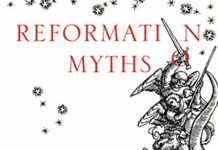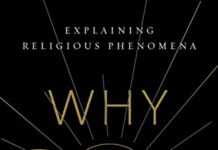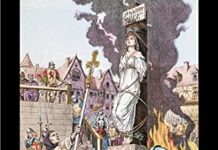
Ebook Info
- Published: 2000
- Number of pages: 351 pages
- Format: PDF
- File Size: 1.53 MB
- Authors: Rodney Stark
Description
Finally, social scientists have begun to attempt to understand religious behavior rather than to discredit it as irrational, ignorant, or foolish—and Rodney Stark and Roger Finke have played a major role in this new approach. Acknowledging that science cannot assess the supernatural side of religion (and therefore should not claim to do so), Stark and Finke analyze the observable, human side of faith. In clear and engaging prose, the authors combine explicit theorizing with animated discussions as they move from considering the religiousness of individuals to the dynamics of religious groups and then to the religious workings of entire societies as religious groups contend for support. The result is a comprehensive new paradigm for the social-scientific study of religion.
User’s Reviews
Reviews from Amazon users which were colected at the time this book was published on the website:
⭐Acts of Faith represents the culmination of more than 30 years of research in the sociology of religion by Rodney Stark (and also Roger Finke). It is Stark’s magnum opus, putting together in one place the distillation of all of his important research, and is the single best book on the sociology of religion that I’ve come across. While no single theory, even a good one, can explain religion adequately, Acts of Faith represents the single best attempt I’ve yet seen. Like any good theory, it has power to explain a wide range of phenomenon. While it’s not a book above criticism, many of the more negative reviews misunderstand what Stark and Finke are actually saying. I first came across this book when I was pursuing my Ph.D. in Religious Studies.Stark and Finke begin by properly destroying the secularization thesis as it was taught for several decades. The old secularization thesis stated things such as “religion is false and harmful” and “religion is doomed.” Stark and Finke’s response is to properly understand the ways in which this older secularization thesis has been radically revised. Not only is religion alive and kicking in the world, but the religious piety of the past was also not as great as has been assumed.The heart of the book deals with what the authors refer to as “the religious economy.” While there are certainly other legitimate ways of analyzing religion, Stark and Finke’s model has great explanatory power. For them, “a religious economy consists of all the religious activity going on in any society.” One of the most important corollaries of this view is that “The capacity of a single religious firm to monopolize a religious economy depends upon the degree to which the state uses coercive force to regulate the religious economy.” This statement is profoundly true and useful: it helps explain, for example, why religion can look strong in state-sponsored churches and yet be inwardly weak. It also helps explain how the Christendom of Europe could give way to the current atheism. In contrast to “religious economies” that are regulated by the state, countries that have unregulated religious economies have religious “competition,” which leads to higher levels of religious commitment. This helps explain, for example, why religion is still a lot stronger in America (historically an unregulated religious economy) than in Europe (historically regulated religious economies).Along the way, Stark and Finke help explain many other human factors associated with religion and religious behavior. One of the most important of all, which everyone should be familiar with, is the notion that the density of social networks helps explain religious conversion: we’re much more likely to convert to a new religion or denomination if the people who are closest to us are involved with the new religion or denomination.The book is tightly argued and clearly presented, but the best feature of all is the back of the book (pages 277-288) where Stark and Finke list, in order, all of the definitions and propositions they have made throughout the book. This is an amazing summary of the book and makes it very easy to rehearse their arguments and to access them for further thought and research. I wish every academic book had this feature!There’s a lot more here than I can explain in a review, but I highly recommend this book for anyone who is serious about the sociology of religion or wants to gain a better insight into the future of religion in the world. Other works by Rodney Stark are also worth reading, but this is the best of the best!
⭐The authors propose that religion is analogous to a commodity that people buy. Religious behavior is said to be the result of people acting in their own interest. It is reinforced by dogmas claiming that good behavior will be rewarded in this life and the afterlife. Feelings of solidarity, friendships between parishioners, and other social interactions also reinforce religious behavior. These factors are most likely to be found in conservative religious groups. These assumptions allow the authors to account for many features of religion in contemporary society.One of their most interesting arguments is that the absence of satisfactory sellers of religion suppresses church attendance in Europe whereas the abundance of denominations in the US stimulates church attendance. An equally interesting topic is the way they account for the decline in the number of people wishing to join Roman Catholic religious orders following Vatican II.The treatment is very compelling but dry and academic. Much of the evidence derives from the authors’ own research which focuses on the US and Europe. Latin America, Canada, Australia, and Islamic countries are not adequately covered. The rest of the world is not covered at all.The book is marred by occasional criticisms of liberal religions, apparently because the authors perceive a bias against conservative religions in the literature. I would have preferred a more objective approach.
⭐My thinking on the subject of church dynamics has been strongly influenced by other works of Stark (The Rise of Christianity) and of Stark and Finke (The Churching of America).This latest in their combined efforts is also quite good. HOWEVER, I have found that a conservative bias is beginning to show. In my opinion, they have let biases against Liberal Theology taint an excellent exposition of research. I will support this statement with an example.They have some excellent numbers which compare the success of Evangelical ministers with in the United Methodist Church to Ministers within the UMC which were co-officiants at a particular homosexual union ceremony. The data clearly indicates that there is stronger growth among the Evangelical ministers. This is used as evidence that “Liberal” (whatever that abused word means) theology is damaging to church growth. I would believe that a better interpretation of this is: Those who go to pick apples get more apples than those who simply seek to polish apples.As long as Stark and Finke stick to their last, they are wonderful, but when they wander over trying to do theology they faulter.I would encourage anyone who is interested in Church Growth and Dynamics to buy this book, but please be sure to be on the alert for the conservative bias.
⭐
⭐
⭐
Keywords
Free Download Acts of Faith: Explaining the Human Side of Religion 1st Edition in PDF format
Acts of Faith: Explaining the Human Side of Religion 1st Edition PDF Free Download
Download Acts of Faith: Explaining the Human Side of Religion 1st Edition 2000 PDF Free
Acts of Faith: Explaining the Human Side of Religion 1st Edition 2000 PDF Free Download
Download Acts of Faith: Explaining the Human Side of Religion 1st Edition PDF
Free Download Ebook Acts of Faith: Explaining the Human Side of Religion 1st Edition




